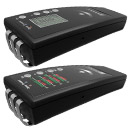|
|
|
|
Results with the using ENART 907
in а complex therapy of urolithiasis
Linskyi I.Z., ENART-practitioner, Ukraine
In this article I would like to share my own results and observations on this issue. Urolithiasis is the second most common kidney disease after pyelonephritis. Medical practitioners, which work in this field (urologists, therapists, doctors of the family medicine) are well aware of the fact that it is not always possible to achieve benefit results with using the conventional therapy of this pathology. The particular and common problem is the process of the excretion of the stones, especially when it comes with the stopping of a concrement in one of the parts of the ureter. A partial or full block of the ureter is often observed with this. In this situation it is needed to remove the blockage and restore the proper function of a kidney, otherwise this may result in complications that can lead to very severe outcomes, up to the full loss of an organ. Traditional therapies (drug therapy, distant lithotripsy (DLT), surgical interference) do not always give positive results and often comes with the range of side effects. ENART-therapy is non-invasive and safe method of treatment, which, with its high effectiveness, has practically no contraindications to application. I made sure of it on my own experience. To acknowledge said above I will describe several cases with using ENART 907 within summer season. In summer, as a rule, the number of cases with complications of urolithiasis with a complication in the form of calculus discharge with attacks of renal colic increases. According to my observations, more than 50% of patients have sticking of stones in an ureter on different levels. I applied ENART-therapy in these cases. I had 5 cases, when stones passed after 2 or 3 sessions of ENART-therapy. In one patient a stone had passed in one hour after the first session had done and absolutely without pain! Other patients noted that a pain had completely disappeared immediately after the session and an attack had been in several hours (the attack was much lower by its intensity and it allowed to do without using analgesics). But no one of them was anxious about that, because I notified them about it beforehand. After an exacerbation that was of short duration, there was either a passage of concrement, or its considerable dislocation down along an ureter with its following passage in a several days. Such examples, as a rule, referred to the cases, when stones were located in a low part of an ureter and by their sizes didn’t exceed 1 centimeter by their diameter. When carrying out a treatment, the following modes were used: DIAGNOST 1, 2; CONSTANT 1, 2; INTERVAL; AM; CS. In cases with the severe pain syndrome, I applied FMVAR. This mode very quickly and for a long period relieves pain, which is very intense during a renal colic attack. But there were also more interesting results, which required much more efforts and patience both from the doctor, and from patients.
I will describe one of them. Another patient, male, 40, renal colic attack. After the proper observation, I diagnosed the patient with urolithiasis. There was the stone (10 mm) at the upper third of the left ureter. The patient was ready to start a conservative treatment (the block of the ureter was incomplete, with the preservation of the function of the kidney), but afterwards (despite of the recommendations) he decided to turn to a private urological centre, where he underwent Remote lithotripsy. An observation carried out in 10 days showed that the stone was at the same place. On finishing the therapy at the centre, he turned to me once again, as the concrement didn’t come off. I suggested the treatment with ENART-therapy. After the first session the patient noted that the pain had moved down along the ureter approximately to 5 centimeters, and after 4 sessions there was a discharge of the concrement. The control observation didn’t show the stones in the left ureter. There was also a patient, male, 67, diagnosed with urolithiasis. The stone (9 mm) was found in the left ureter. The renal pelvis on the left was broadened by 25 mm (up to 35 mm). The patient refused inpatient treatment and preferred to take phytopreparations combined with the sessions of ENART-therapy. After two sessions control observation showed that the function of the kidney improved, the size of the pelvis decreased by the 15 mm (up to 20). The pain syndrome was almost removed. But the patient, having been advised by some of his relatives, interrupted the treatment. The further status of his health is unknown to me. Based on the said above, I can make definite conclusion, that ENART-therapy is very effective method for urolithiasis complications, and in further it will be more and more implemented into the practice of specialists dealing with this problem. It can be applied both with complex therapy, and as a monotherapy (an independent therapy), when a patient would refuse consciously from the traditional therapy.
<<< Return to Results with using ENART
|
| |||||||||||||||||||||||





